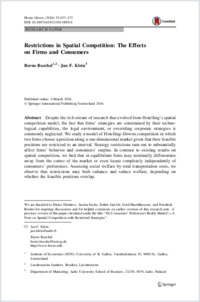Restrictions in Spatial Competition : The Effects on Firms and Consumers
- Buechel, Berno University of St. Gallen & Liechtenstein-Institute
- Klein, Jan F. Aalto University
-
2016
Published in:
- Homo economicus. - 2016, vol. 33, no. 1-2, p. 157-172
English
Despite the rich stream of research that evolved from Hotelling’s spatial competition model, the fact that firms’ strategies are constrained by their technological capabilities, the legal environment, or overriding corporate strategies is commonly neglected. We study a model of Hotelling–Downs competition in which two firms choose a position along a one-dimensional market given that their feasible positions are restricted to an interval. Strategy restrictions turn out to substantially affect firms’ behavior and consumers’ surplus. In contrast to existing results on spatial competition, we find that in equilibrium firms may minimally differentiate away from the center of the market or even locate completely independently of consumers’ preferences. Assessing social welfare by total transportation costs, we observe that restrictions may both enhance and reduce welfare, depending on whether the feasible positions overlap. This document contains some supplemental material. We introduce and discuss a particular model to substantiate the assertion made in the note that the novel cases can also emerge when restrictions are endogenously, not exogenously, determined. In the note we refer to this material in Section 4 in footnote 11.
- Faculty
- Faculté des sciences économiques et sociales et du management
- Department
- Département d'économie politique
- Language
-
- English
- Classification
- Economics
- License
- License undefined
- Identifiers
-
- RERO DOC 327292
- DOI 10.1007/s41412-016-0003-6
- Persistent URL
- https://folia.unifr.ch/unifr/documents/308108
Other files
Statistics
Document views: 112
File downloads:
- buechel_klein_homo_oec_publishedversion_0.pdf: 204
- buechel_klein_supplemental_analysis_long_run.pdf: 98

